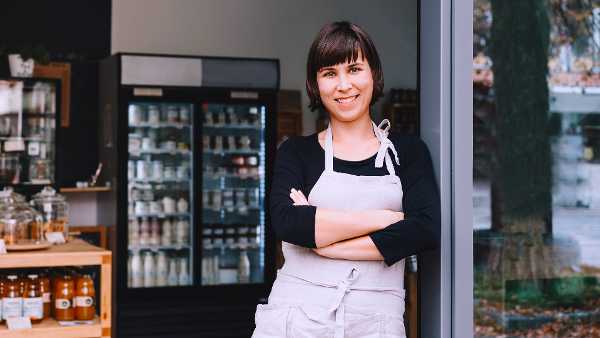A business model with sustainability at its core gives opportunities
- Danitsja Kallendorf
- Step-by-step plan
- 26 April 2023
- Edited 29 July 2024
- 4 min
- Managing and growing
- Sustainability
Going green and earning money are 2 important business ambitions, but how can you combine them? Start by mapping your business model. This is possible with the Business Model Canvas, a handy tool that shows you where your company can make a difference for people, the environment, and society.
Sustainability offers opportunities to earn extra income. Also, as an entrepreneur you have to become more and more sustainable due to laws and regulations. But where do you start? The Business Model Canvas is a practical exercise that helps you describe and examine your business model. You will discover the strengths and weaknesses of your organisation and product or service. And the model can help you make your company more sustainable. Follow all the steps to find opportunities to give sustainability a place within your company.
This is how you bring sustainability into your business model
Get started with the Business Model Canvas with this sample template. Fill it in digitally, or print it out in a large format and stick it on the wall. Then follow the steps below and define the different parts of your company. These are also known as building blocks. You can do this alone or during a brainstorming session with your team.
1. Know who your customer is
Who are your customers and what are their needs? These are the first questions you answer when you get started with the model. Chances are that your customers find sustainability important, just like most Dutch consumers (in Dutch). Investigate if you will attract and retain customers if you make your product or service more sustainable. For example, by researching customer behaviour in your industry. Or by sending a short questionnaire to your customers. You can also ask for the reason for purchase when selling. This gives you direct insight into the sustainable wishes of your customer.
2. Be sure of the value of your product or service
The value proposition is the second building block. Here you describe why people choose your product or service. Is the brand especially important or is it your price? Or do people choose your product because it is more environmentally friendly than that of the competitor? Investigate if you produce your product fairly, for example with the CSR Risk . Is your product already sustainable? Show that with a sustainability label. Check that the label you choose is trustworthy and beware of greenwashing - pretending to be more sustainable then you are.
3. Make distribution and delivery more sustainable
Your product ends up in the hands of your customer through distribution and sales channels. Does your company work sustainably, but your courier does not? See if you can switch to a CO2-neutral delivery service. And opt for collection locations instead of home delivery. This reduces the CO2 footprint of your business.
4. Look at customer relations
In the fourth building block, you describe your relationship with the customer. Is that relationship personal or automated? Is contact online or offline? Perhaps it suits your company to reward customers for green behaviour with a discount or savings card. For example, when they reuse old packaging, or when they bring their own cup when getting some coffee.
5. Explore opportunities for extra income
You have arrived at building block 5: income. Ask yourself the following questions: can I make money with sustainability initiatives? Or can I boost my existing revenue model with sustainable alternatives? For example, you can also rent out toys, clothing, or tools, in addition to selling. Buying less leads to less production and so is more sustainable. If your company is sustainable, you are more likely to qualify for government tenders.
6. Examine your core resources
The sixth building block is about your core resources, such as equipment and raw materials. Explore what adjustments you can make here. Do you run a circular business? Then you are less dependent on prices and delivery times of raw materials. Also, consider how you handle waste. And if you can (re)use raw materials for a longer period of time. The government stimulates circular entrepreneurship with financial aid.
7. Extend the life of your product
Fill in your core activities in the seventh building block. Those are your main business activities. With this building block, you look at the design and how your product is made. Do you produce a lot for little? Or do you always choose the best quality? Perhaps your customer values as little waste as possible. Investigate if you can improve the quality of your product. This way you ensure that your product lasts longer, making it more durable and sustainable. As an additional activity, you can offer help with repairs. This will become mandatory in and makes your product a sustainable choice for the customer.
Check your registration
When you change your business model, you may also have to change your registration in the Business Register. Regularly check your registration in the Business Register, to see if your company details are still up-to-date. And report changes to KVK.
8. Be part of a sustainable chain
With the right partners, you become more sustainable more quickly. For example, choose partners who work in a socially responsible manner. Think of a collaboration with a a social help organisation or a repair cafe. Have you set ambitious sustainability goals for your own business? Then you can do that for your partners as well. For example, include CSR agreements in your supplier contracts. Or draw up improvement plans and goals for the entire chain, together with your partners.
9. Calculate the costs of sustainability
Costs are part of making your business model more sustainable. Identify what you need financially. And see if you can make use of subsidies and schemes. Deduction schemes such as the KIA, EIA, MIA, and Vamil make investing in sustainability cheaper. And through the And through the Subsidy Programme for Responsible , SPVO, you and your suppliers can get help to make the production chain more sustainable.
Do you need to borrow money for your green plans? Then you can use the SME-credit scheme BMKB-Green. The government provides a guarantee, making it easier for you to get a loan.

